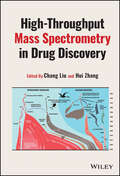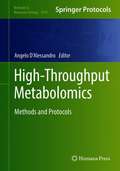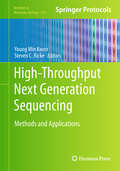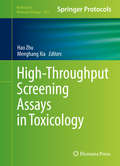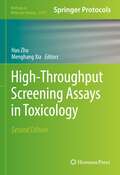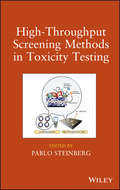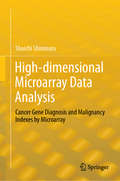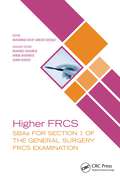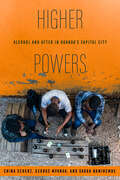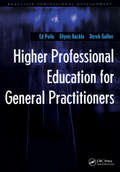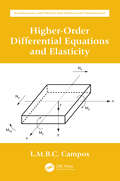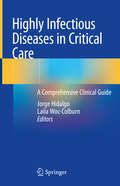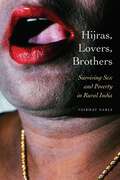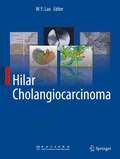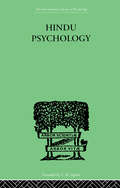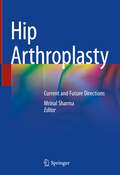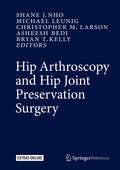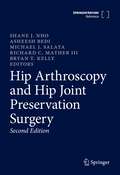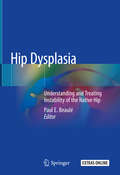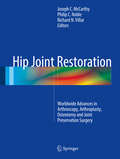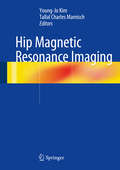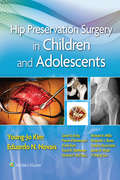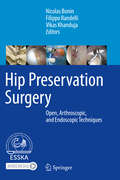- Table View
- List View
High-Throughput Mass Spectrometry in Drug Discovery
by Hui Zhang Chang LiuHigh-Throughput Mass Spectrometry in Drug Discovery Apply mass spectrometry to every phase of new drug discovery with this cutting-edge guide Mass spectrometry is a technique that identifies and characterizes compounds based on their mass — the fundamental molecular characteristic. It has become an invaluable analytical tool in various disciplines, industries, and research fields. It has become particularly central to new drug discovery and development, which broadly deploys mass spectrometry at every phase. The pharmaceutical industry has become one of the main drivers of technological development in mass spectrometry. High-Throughput Mass Spectrometry in Drug Discovery offers a comprehensive introduction to mass spectrometry and its applications in pharmaceutical discovery. It covers the foundational principles and science of mass spectrometry before moving to specific experimental methods and their applications at various stages of drug discovery. Its thorough treatment and detailed guidance make it an invaluable tool for pharmaceutical research and development. High-Throughput Mass Spectrometry in Drug Discovery readers will also find: Detailed analysis of techniques, including label-free screening, synthetic reaction optimization, and more An authorial team with extensive combined experience in research and industrial applications Technical strategies with the potential to accelerate quantitative bioanalysis in drug discovery High-Throughput Mass Spectrometry in Drug Discovery is essential for analytical, bioanalytical, and medicinal chemists working in the pharmaceutical industry and for any researchers and graduate students interested in drug discovery and development.
High-Throughput Metabolomics: Methods and Protocols (Methods in Molecular Biology #1978)
by Angelo D'AlessandroThis detailed volume focuses on recent technological, computational, and biostatistical advances in the field of high-throughput metabolomics. Chapters encompass methods, platforms, and analytical strategies for steady state measurements and metabolic flux analysis with stable isotope-labeled tracers, in biological matrices of clinical relevance and model organisms. Mass spectrometry-based or orthogonal methods are discussed, along with computational and statistical methods to address data sparsity in high-throughput metabolomics approaches. As a part of the highly successful Methods in Molecular Biology series, chapters include introductions to their respective topics, lists of the necessary materials and reagents, step-by-step, readily reproducible laboratory protocols, and tips on troubleshooting and avoiding known pitfalls. Authoritative and practical, High-Throughput Metabolomics: Methods and Protocols provides tools that can bring about the next generation of clinical biochemistry in a cost-effective, rigorous fashion, exponentially advancing our capacity to investigate nature while hastening the advent of personalized medicine.
High-Throughput Next Generation Sequencing
by Steven C. Ricke Young Min KwonDue to their novel concepts and extraordinary high-throughput sequencing capacity, the "next generation sequencing" methods allow scientists to grasp system-wide landscapes of the complex molecular events taking place in various biological systems, including microorganisms and microbial communities. These methods are now being recognized as essential tools for a more comprehensive and deeper understanding of the mechanisms underlying many biological processes. In High-Throughput Next Generation Sequencing: Methods and Applications, experts in the field explore the most recent advances in the applications of next generation sequencing technologies with an emphasis on microorganisms and their communities; however, the methods described in this book will also offer general applications relevant to the study of any living organisms. Written in the highly successful Methods in Molecular BiologyTM series format, chapters include introductions to their respective topics, lists of the necessary materials and reagents, step-by-step, readily reproducible laboratory protocols, and key tips on troubleshooting and avoiding known pitfalls. Comprehensive and cutting-edge, High-Throughput Next Generation Sequencing: Methods and Applications is an excellent collection of chapters to aid all scientists who wish to apply these innovative research tools to enhance their own pursuits in microbiology and also biology in general.
High-Throughput Screening Assays in Toxicology
by Hao Zhu Menghang XiaThis book focuses on recently developed High Throughput Screening (HTS) assay protocols, many involved in the ToxCast and/or Tox21 initiatives, and the relevant HTS data analysis techniques. Divided into three sections, in vitro assays, in vivo assays, and computational techniques to analyze HTS data are all examined. Written for the highly successful "Methods in Molecular Biology" series, most chapters include introductions to their respective topics, lists of the necessary materials and reagents, step-by-step, readily reproducible laboratory protocols, and tips on troubleshooting and avoiding known pitfalls. Authoritative and practical, "High Throughput Screening Assays in Toxicology" serves as a valuable reference resource for translating new HTS techniques into standardized chemical toxicity assessment tools in order to advance modern toxicology research to a new era where HTS techniques can partially replace the prevailing animal models.
High-Throughput Screening Assays in Toxicology (Methods in Molecular Biology #2474)
by Hao Zhu Menghang XiaThis second edition volume expands on the previous edition by exploring the latest advancements in high throughput screening (HTS) in toxicity studies by using in vitro, ex vivo, and in vivo models. This volume also covers the application of artificial intelligence (AI) and data science to curate, manage, and use HTS data. Written in the highly successful Methods in Molecular Biology series format, chapters include introductions to their respective topics, lists of the necessary materials and reagents, step-by-step, readily reproducible laboratory protocols, and tips on troubleshooting and avoiding known pitfalls. Cutting-edge and thorough, High Throughput Screening Assays in Modern Toxicology, Second Edition is a valuable resource for scientists pursuing chemical toxicology research. This book will aid scientists and researchers in translating new HTS techniques into standardized chemical toxicology assessment tools that can refine, reduce, and replace animal testing.
High-Throughput Screening Methods in Toxicity Testing
by Pablo SteinbergExplores the benefits and limitations of the latest high-throughput screening methods With its expert coverage of high-throughput in vitro screening methods for toxicity testing, this book makes it possible for researchers to accelerate and streamline the evaluation and risk assessment of chemicals and drugs for toxicity. Moreover, it enables them to comply with the latest standards set forth by the U.S. National Research Council's "Toxicity Testing in the 21st Century: A Vision and Strategy" and the E.U.'s REACH legislation. Readers will discover a variety of state-of-the-science, high-throughput screening methods presented by a group of leading authorities in toxicology and toxicity testing. High-Throughput Screening Methods in Toxicity Testing is divided into five parts: General aspects, including predicting the toxicity potential of chemicals and drugs via high-throughput bioactivity profiling Assessing different cytotoxicity endpoints Assessing DNA damage and carcinogenesis Assessing reproductive toxicity, cardiotoxicity, and haematotoxicity Assessing drug metabolism and receptor-related toxicity Each chapter describes method principles and includes detailed information about data generation, data analysis, and applications in risk assessment. The authors not only enumerate the advantages of each high-throughput method over comparable conventional methods, but also point out the high-throughput method's limitations and potential pitfalls. In addition, the authors describe current research efforts to make high-throughput toxicity screening even more cost effective and streamlined. Throughout the book, readers will find plenty of figures and illustrations to help them understand and perform the latest high-throughput toxicity screening methods. This book is ideal for toxicologists and other researchers who need to implement high-throughput screening methods for toxicity testing in their laboratories as well as for researchers who need to evaluate the data generated by these methods.
High-dimensional Microarray Data Analysis: Cancer Gene Diagnosis and Malignancy Indexes by Microarray
by Shuichi ShinmuraThis book shows how to decompose high-dimensional microarrays into small subspaces (Small Matryoshkas, SMs), statistically analyze them, and perform cancer gene diagnosis. The information is useful for genetic experts, anyone who analyzes genetic data, and students to use as practical textbooks.Discriminant analysis is the best approach for microarray consisting of normal and cancer classes. Microarrays are linearly separable data (LSD, Fact 3). However, because most linear discriminant function (LDF) cannot discriminate LSD theoretically and error rates are high, no one had discovered Fact 3 until now. Hard-margin SVM (H-SVM) and Revised IP-OLDF (RIP) can find Fact3 easily. LSD has the Matryoshka structure and is easily decomposed into many SMs (Fact 4). Because all SMs are small samples and LSD, statistical methods analyze SMs easily. However, useful results cannot be obtained. On the other hand, H-SVM and RIP can discriminate two classes in SM entirely. RatioSV is the ratio of SV distance and discriminant range. The maximum RatioSVs of six microarrays is over 11.67%. This fact shows that SV separates two classes by window width (11.67%). Such easy discrimination has been unresolved since 1970. The reason is revealed by facts presented here, so this book can be read and enjoyed like a mystery novel. Many studies point out that it is difficult to separate signal and noise in a high-dimensional gene space. However, the definition of the signal is not clear. Convincing evidence is presented that LSD is a signal. Statistical analysis of the genes contained in the SM cannot provide useful information, but it shows that the discriminant score (DS) discriminated by RIP or H-SVM is easily LSD. For example, the Alon microarray has 2,000 genes which can be divided into 66 SMs. If 66 DSs are used as variables, the result is a 66-dimensional data. These signal data can be analyzed to find malignancy indicators by principal component analysis and cluster analysis.
Higher FRCS: SBAs for Section 1 of the General Surgery FRCS Examination
by Mohamed Baguneid Arnab Bhowmick Muhammad Rafay Sameem Siddiqui Jemma BhodayA new revision guide designed to help candidates prepare for the first part of the FRCS general surgery exam. Due to a lack of preparatory resources for the exam, this book bridges the gap, offering updated guidelines and information which will help candidates succeed. It acts as a supportive revision guide which will enrich other FRCS exam resources. This resource provides an updated approach to the FRCS exam. Using questions written by practicing surgeons, the book offers more contemporary revision materials, touching on topics not widely covered in other FRCS revision aids. Readers will gain a familiarity with the style of the FRCS exam, as Higher FRCS uses a style reflective of the exam to enhance the candidate’s knowledge, confidence, and preparation. The audience for this book includes general surgery trainees who are preparing for their higher exams (including FRCS), alongside surgical trainees taking the MRCS. It is also a beneficial resource for students in other medical courses studying for surgical exams.
Higher Powers: Alcohol and After in Uganda’s Capital City
by China Scherz George Mpanga Sarah NamirembeHigher Powers draws on four years of collaborative fieldwork carried out with Ugandans working to reconstruct their lives after attempting to leave behind problematic alcohol use. Given the relatively recent introduction of biomedical ideas of alcoholism and addiction in Uganda, most of these people have used other therapeutic resources, including herbal aversion therapies, engagements with balubaale spirits, and forms of deliverance and spiritual warfare practiced in Pentecostal churches. While these methods are at times severe, they contain within them understandings of the self and practices of sociality that point away from models of addiction as a chronic relapsing brain disease and towards the possibility of release. Higher Powers offers a reconceptualization of addiction and recovery that may prove relevant well beyond Uganda.
Higher Professional Education for General Practitioners
by Ed Peile Glynis Buckle Derek GallenHigher Professional Education for General Practitioners is a practical guide on the best ways to plan educational and vocational training needs throughout professional practice. It clearly outlines the underlying issues surrounding the introduction of higher professional education (HPE) enabling newly qualified professionals to focus on areas that they feel less competent in, and areas that require additional training. In an easy-to-read format it provides all the necessary information to assist readers undertaking HPE, and for all those setting up educational programmes for newly qualified GPs in the first year after their vocational training scheme.
Higher-Order Differential Equations and Elasticity (Mathematics and Physics for Science and Technology)
by Luis Manuel Braga da Costa CamposHigher-Order Differential Equations and Elasticity is the third book within Ordinary Differential Equations with Applications to Trajectories and Vibrations, Six-volume Set. As a set, they are the fourth volume in the series Mathematics and Physics Applied to Science and Technology. This third book consists of two chapters (chapters 5 and 6 of the set). The first chapter in this book concerns non-linear differential equations of the second and higher orders. It also considers special differential equations with solutions like envelopes not included in the general integral. The methods presented include special differential equations, whose solutions include the general integral and special integrals not included in the general integral for myriad constants of integration. The methods presented include dual variables and differentials, related by Legendre transforms, that have application in thermodynamics. The second chapter concerns deformations of one (two) dimensional elastic bodies that are specified by differential equations of: (i) the second-order for non-stiff bodies like elastic strings (membranes); (ii) fourth-order for stiff bodies like bars and beams (plates). The differential equations are linear for small deformations and gradients and non-linear otherwise. The deformations for beams include bending by transverse loads and buckling by axial loads. Buckling and bending couple non-linearly for plates. The deformations depend on material properties, for example isotropic or anisotropic elastic plates, with intermediate cases such as orthotropic or pseudo-isotropic. Discusses differential equations having special integrals not contained in the general integral, like the envelope of a family of integral curves Presents differential equations of the second and higher order, including non-linear and with variable coefficients Compares relation of differentials with the principles of thermodynamics Describes deformations of non-stiff elastic bodies like strings and membranes and buckling of stiff elastic bodies like bars, beams, and plates Presents linear and non-linear waves in elastic strings, membranes, bars, beams, and plates
Highland Fling with Her Best Friend
by Becky WicksIn the latest Harlequin Medical Romance novel by Becky Wicks, could it be possible that the love of this doctor&’s life has been right in front of her this whole time in the shape of her best friend?A fresh start……with an old friend! After a bad breakup, Dr. Sadie Mills is offered a new job at an exclusive health facility in Scotland with her best friend! It sounds like the perfect escape. Sadie&’s never worked with Dr. Owen Penner before, but why would that be an issue? She loves Owen and has never been tempted to date such a committed playboy. Yet suddenly she wants to shove him out of the friend zone—straight into her bed!From Harlequin Medical: Life and love in the world of modern medicine.
Highly Infectious Diseases in Critical Care: A Comprehensive Clinical Guide
by Jorge Hidalgo Laila Woc-ColburnThis book provides a comprehensive overview of highly infectious diseases (HIDs) in the ICU. The text is designed to help critical care specialists and other healthcare practitioners prepare and plan for potential outbreaks of emerging or resurgent HIDs, lead a team in the ICU, perform emergency triage, and provide care for patients with a HID. The book also reviews some of the most prevalent highly infectious diseases, including influenza, SARS, plague, anthrax, and malaria.Written by experts in the field, Highly Infectious Diseases in Critical Care: A Comprehensive Clinical Guide is a valuable resource for critical care and infectious disease specialists who treat patients afflicted with a highly infectious disease in the ICU.
Hijras, Lovers, Brothers: Surviving Sex and Poverty in Rural India (Thinking from Elsewhere)
by Vaibhav SariaWinner, 2023 Bernard S. Cohn Prize, Association for Asian StudiesWinner, 2021 Joseph W. Elder Prize in the Indian Social SciencesWinner, 2021 Ruth Benedict Prize, Association for Queer AnthropologyHonorable Mention, 2023 Anne Bolin & Gil Herdt Book Prize, Human Sexuality & Anthropology Interest GroupHijras, one of India’s third gendered or trans populations, have been an enduring presence in the South Asian imagination—in myth, in ritual, and in everyday life, often associated in stigmatized forms with begging and sex work. In more recent years hijras have seen a degree of political emergence as a moral presence in Indian electoral politics, and with heightened vulnerability within global health terms as a high-risk population caught within the AIDS epidemic. Hijras, Lovers, Brothers recounts two years living with a group of hijras in rural India. In this riveting ethnography, Vaibhav Saria reveals not just a group of stigmatized or marginalized others but a way of life composed of laughter, struggles, and desires that trouble how we read queerness, kinship, and the psyche.Against easy framings of hijras that render them marginalized, Saria shows how hijras makes the normative Indian family possible. The book also shows that particular practices of hijras, such as refusing to use condoms or comply with retroviral regimes, reflect not ignorance, irresponsibility, or illiteracy but rather a specific idiom of erotic asceticism arising in both Hindu and Islamic traditions. This idiom suffuses the densely intertwined registers of erotics, economics, and kinship that inform the everyday lives of hijras and offer a repertoire of self-fashioning beyond the secular horizons of public health or queer theory.Engrossingly written and full of keen insights, the book moves from the small pleasures of the everyday—laughter, flirting, teasing—to impossible longings, kinship, and economies of property and substance in order to give a fuller account of trans lives and of Indian society today.
Hilar Cholangiocarcinoma
by W. Y. LauThis is a multi-author book on hilar cholangiocarcinoma, written by an international team of world-renowned experts covering topics in their respective areas of expertise. There are altogether 71 authors from 14 countries/regions, mainly Argentina, Australia, China, Germany, Italy, Japan, Korea, Malaysia, Thailand, the Netherlands, the United Kingdom and the United States of America. This book aims to provide an up-to-date, fully referenced text that is as succinct as possible, but as comprehensive as necessary, addressing all topics in hilar cholangiocarcinoma. It provides the latest findings in the rapidly advancing field of hilar cholangiocarcinoma. Controversial aspects are discussed by highly regarded authorities who look at the problem from different perspectives. A helpful list of references is included at the end of each chapter. The extensive use of diagrams, figures and tables makes the text easy to read. This book is primarily intended for clinicians and researchers who are interested in hilar cholangiocarcinoma, including liver surgeons, hepatologists, interventional and diagnostic radiologists, and basic researchers. General physicians, general surgeons, trainees, epidemiologists, hospital administrators, pathologists and instrument manufacturers will also find this book to be a valuable reference work. Editor Lau is currently a Professor of Surgery at the Chinese University of Hong Kong, and an Academician of Chinese Academy of Sciences, China.
Hindu Psychology: Its Meaning for the West (International Library Of Psychology Ser.)
by Swami AkhilanandaThe six volume Psychology ann Religion set of the International Library of Psychology explores the interface between psychology and religion, looking at aspects of religious belief and mysticism as related to the study of human consciousness. Hindu Psychology looks at the relevance of Hindu belief systems and theories of perception for the West.
Hintere Kreuzbandplastik (Operationstechniken Orthopädie Unfallchirurgie)
by Christian Konrads Sufian Ahmad Atesch Ateschrang Stefan Döbele Ulrich StöckleDas Buch beschreibt den Ersatz des hinteren Kreuzbandes mit autologer Semitendinosussehne und Grazilissehne in Einzelbündeltechnik. Der Schwerpunkt liegt dabei auf der Praxis: die Operation wird Schritt für Schritt beschrieben und zahlreiche brillante Grafiken und Fotos visualisieren die Operation. Darüber hinaus demonstriert ein 10-minütiges Video den Operationsverlauf. So ist die Umsetzung der Theorie in die Praxis auf kurzem Weg möglich.
Hip Arthroplasty: Current and Future Directions
by Mrinal SharmaThis book brings together the latest updates and current trends in arthroplasty of the hip covering the basics as well as complex and revision surgery. Eminent arthroplasty surgeons across the globe have contributed to the chapters and shared their clinical experiences. There are separate sections on primary hip arthroplasty, complex scenarios requiring hip replacement, and detailed management of related complications. It covers revision hip replacement in detail with the latest updates on surgical techniques and implants. There are separate sections on computer navigation and robotic-assisted hip replacement surgeries. A special section on implants and tribology has been added. The language of the book is easy-to-read, user friendly with pictorial representation of relevant surgical steps. Case-based discussions, surgical tips, and summary has been added in each chapter. The references given at the end of each chapter would be useful for those doing research. This book is an essential on-the-desk book for practicing orthopedic surgeons across the globe, beginners in arthroplasty surgery, postgraduate students of orthopedics, DNB students, and those interested in research.
Hip Arthroscopy and Hip Joint Preservation Surgery
by Shane J. Nho Michael Leunig Christopher M. Larson Asheesh Bedi Bryan T. KellyHip pathology and nonarthritic hip conditions have only recently been recognized as a cause of hip pain. In 2003, Ganz, Leunig and colleagues described the concept of femoroacetabular impingement (FAI) as a cause of hip pain and a mechanism for end-stage hip osteoarthritis. Ganz et al. also postulated that 70-90% of hip osteoarthritis is likely due to abnormal hip mechanics related to FAI, dysplasia, or other hip deformities. Over the past ten years, the treatment of these non-arthritic hip pathologies has grown dramatically, and has been estimated to grow by 15% each year. It is the largest segment of grown in sports medicine and orthopedics as a whole. However, no definitive reference yet exists on hip arthroscopy and hip joint preservation surgery. While books have been published on hip arthroscopy, these texts are limited to the technical aspects of the procedure and do not explore content related to hip joint preservation surgery. The scope of this book covers the basic science of hip pathology, anatomy, biomechanics, pathology, and treatment. It has put together up-to-date research and has invited opinion leaders in the field to contribute to the text. The book is focused on disease pathology and provides comprehensive information on each disease topic, which is followed by technique-driven chapters to provide surgeons a reference for any procedure related to non-arthritic conditions of the hip. "
Hip Arthroscopy and Hip Joint Preservation Surgery
by Shane J. Nho Asheesh Bedi Bryan T. Kelly Michael J. Salata Richard C. MatherThe field of hip preservation surgery has evolved over the past decade as our understanding of hip pathomechanics and pathomorphology has expanded. The published literature on non-arthritic hip pathology, for example, has grown exponentially. The topics of controversy in the past decade have been answered in some cases, but new questions have also arisen. In addition to the 99 chapters in the original edition – most of which will be retained and updated as applicable – there will be over 30 brand new chapters focusing on new and more sophisticated techniques from authors that have been the pioneers of the field. The text is divided into nine thematic sections, covering the breadth of the topic and the current state of the art: basic science of the hip; operative basics for hip arthroscopy and open hip preservation surgery; pediatric hip conditions; approaches to disorders of the hip and pelvis; enthesopathy and neuromuscular disorders; hip fractures and instability; avascular necrosis; hip cartilage restoration; and oncologic conditions. Throughout, there is a heavy emphasis on surgical techniques, and video clips will be included in selected chapters. Written by edited by thought leaders and seasoned practitioners in the field, this new edition of Hip Arthroscopy and Hip Joint Preservation Surgery will remain the gold standard for orthopedic surgeons and sports medicine specialists, expanding on the range of techniques available to clinicians treating injuries to and disorders of the hip.
Hip Dysplasia: Understanding and Treating Instability of the Native Hip
by Paul E. BeauléThis book represents the most advanced understanding of diagnosis and management of hip dysplasia in the young adult, written by the world’s leading experts and covering advanced imaging and biomechanical studies as well as latest surgical techniques. This is especially timely, as the field of hip preservation surgery is in constant evolution, and it is critical that surgeons and researchers combine their efforts to provide the best evidence-based knowledge to all health care providers evaluating and treating patients suffering from pre-arthritic hip pain. Not only does this book discuss the most up-to-date information on the etiology and natural history of hip dysplasia, as well as pathomechanics and traditional and advanced imaging, it also presents new conceptions of its classification and subsequent management. The focus throughout the book is that hip dysplasia is a problem of instability, where both the bony structure and the soft tissue envelope (i.e., capsule, ligaments and muscles) are at play. Moreover, although corrective osteotomies such as the peri-acetabular osteotomy will remain the dominant treatment option, non-surgical treatments as well as hip arthroscopy are now being increasingly recognized as useful adjuncts in order for our patients to return to their desired activities. Finally, as the longevity of joint replacement surgery has improved dramatically, this should be strongly considered in cases where the outcome of joint preserving surgery is not as predictable. Orthopedic surgeons, sports medicine physicians, physiatrists and physiotherapists alike will find this book a valuable resource when treating the young adult with symptomatic hip dysplasia.
Hip Joint Restoration
by Joseph C. Mccarthy Philip C. Noble Richard N. VillarHip Joint Restoration is a comprehensive yet practical guide to the basic science and clinical applications of arthroscopy, arthroplasty, osteotomy and preservation surgery for the treatment of diseases and conditions of the hip. This generously illustrated text offers a comprehensive introduction to essential features of hip evaluation, the medical management of hip procedures, and treatment of specific conditions, and covers practical topics such as surgical anatomy of the hip, surgical approaches, instrumentation, and indications for arthroscopy and other surgical procedures aimed at restoration of the hip joint. Additional chapters cover clinical outcomes and equality of life following hip surgery, the current state of research and education of arthroscopic hip procedures throughout the world, other topics such as complications and rehabilitation in different patient populations. This book will be a useful resource for Orthopedic Surgeons and Osteopaths who perform open and arthroscopic hip preservation and total joint replacement, as well as for orthopedic residents and researchers.
Hip Magnetic Resonance Imaging
by Young-Jo Kim Tallal Charles MamischHip Magnetic Resonance Imaging presents a basic yet comprehensive discussion of the role and use of MRI in the diagnosis and treatment of injuries and diseases of the hip, highlighting common concerns and procedures. Beginning with the principles of MRI and dGEMRIC and moving on to normal and abnormal hip anatomy, the focus shifts to the MRI techniques used in the detection of disease conditions of the hip, including labral disease, osteonecrosis, extra-articular conditions and cartilage damage. Chapters on the utilization of biochemical imaging biomarkers in the treatment of hip disorders round out the text. Written by experts in radiology and orthopedics and generously illustrated with MRI radiographs, this book will be an important reference work for clinicians in those fields, as well as practitioners of sports medicine and primary care physicians.
Hip Preservation Surgery in Children and Adolescents
by Young-Jo Kim Eduardo NovaisThe first comprehensive reference in this important area of pediatric orthopaedics, Hip Preservation Surgery in Children and Adolescents, provides authoritative, highly illustrated guidance. Dr. Young-Jo Kim and his team at Boston Children’s Hospital are pioneers in the development of hip preservation techniques in children and adolescents with hip abnormalities and hip pain. This outstanding author team provides the information you need to avoid both osteoarthritis and hip replacement in this vulnerable patient population.
Hip Preservation Surgery: Open, Arthroscopic, and Endoscopic Techniques
by Nicolas Bonin Filippo Randelli Vikas KhandujaThis book offers practical guidance on all procedures that may be performed within the field of hip preservation surgery, arthroscopy, and endoscopy. European experts share their experiences on everything from basic injections to the most challenging hip procedures, offering step-by-step tutorials and highlighting important tips and tricks. Whereas most books on hip arthroscopy and hip preservation surgery concentrate on pathologies, surgical indications, and the basics of the treatment, here the focus is very much on the individual techniques and recognized variants. These techniques are clearly and precisely described with the aid of a wealth of photo and video illustrations. The coverage encompasses procedures applicable in the widest range of scenarios, including synovial pathologies, labral, chondral, and bony injuries, hip impingement, dysplasia and instability, snapping hips, gluteus medius and minimus tendonitis and tears, other tendinopathies, post-arthroplasty complications, and rehabilitation. The book is published in cooperation with ESSKA and will be an essential aid for orthopaedic surgeons at all levels of experience.
